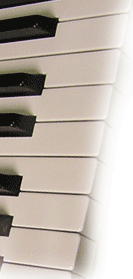
We've prepared a series of videos describing some of the intricacies of the piano keyboard and its repair. We hope you enjoy these glimpses behind the keys:
- Repinning the balance rail
- Key repair and reinforcement
- Piano keyboard evaluated for keybutton replacement
- Pulley keys or chucking piano keys
- Custom soundboard cauls (part 1)
- Custom soundboard cauls (part 2)
- Balance hole, button, and keypin misalignment (part 1)
- Balance hole, button, and keypin misalignment (part 2)
- Wear patterns for key bushings
- Worn out piano keypins balance rail and front rail
- Jointing ivory heads and tails for piano keys
- Keytops for pianos and organs
- Ivory piano or organ keytop restoration (part 1)
- Ivory piano or organ keytop restoration (part 2)
- Ebony sharps, compare and constrast
- Colored piano keys
- Assessing a keyboard for restoration
- Concert grand piano key reinforcement (in depth)
- Characteristics of a well-spaced keyboard
- Ebony sharps restoration (before)
- Ebony sharps restoration (after)
- Shipping your keyboard
If your key actions have become sloppy, moving fore and aft and side to side, you may need to have your balance rail repinned. The pins hold the keys vertical on the keyframe, serve as the key's fulcrum, as well as maintain the spacing between each key.
Back to topCertain parts of a piano's keys inevitably wear over time, leaving you with loose, wiggly keys that may not even sit level. We've found some older model key designs better-made than newer models, which were often trimmed back as cost-cutting measures. In a routine maintenance, replacing the wear items on newer keys with the older design will add the power, tone, and presence back to the instrument that was lost when the key designs were changed.
Back to topThis video stresses the importance of evaluating the keyboard properly and replacing what is there, not what is conveniently available or within the technicians' mechanical abilities. Changing the original parts with parts of different specifications can introduce new variables with potentially unwanted results.
Back to topPulley keys or chucking keys are piano or organ keys in which the balance hole at the bottom of the key has worn out and elongated. This elongation causes the key to move in and out and side to side. This condition will be felt by the player and is distracting. It can also cause unwanted noises and will make the "action" of the instrument less responsive. We can resolve this condition and restore the proper functionality of the instrument.
Back to topThe first of the two videos showing the misalignment of the button and balance hole through which the pin goes through. This misalignment is common in one era of instruments and can cause unwanted friction, poor key to key spacing, and loose key mortices if overeased as a corrective measure.
Back to topThe second half, going over the misalignment of the balance hole and button through which the pin goes.
Back to topThis video shows how ivory heads and tails are "jointed' to square them up prior to application on a "two piece" ivory keytop application.
Back to topThis video discusses the different types of keytop options we offer at Blackstone Valley Piano and briefly describes their properties and application.
Back to topWe’ve repaired too many keyframes and individual keys not to appreciate the need for well-built, custom-designed, custom-made cases for our clients.
Back to top